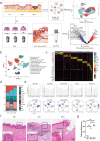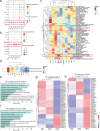Single-cell RNA sequencing reveals the impaired epidermal differentiation and pathological microenvironment in diabetic foot ulcer
- PMID: 40040959
- PMCID: PMC11879498
- DOI: 10.1093/burnst/tkae065
Single-cell RNA sequencing reveals the impaired epidermal differentiation and pathological microenvironment in diabetic foot ulcer
Abstract
Background: Diabetic foot ulcer (DFU) is one of the most common and complex complications of diabetes, but the underlying pathophysiology remains unclear. Single-cell RNA sequencing (scRNA-seq) has been conducted to explore novel cell types or molecular profiles of DFU from various perspectives. This study aimed to comprehensively analyze the potential mechanisms underlying impaired re-epithelization of DFU in a single-cell perspective.
Methods: We conducted scRNA-seq on tissues from human normal skin, acute wound, and DFU to investigate the potential mechanisms underlying impaired epidermal differentiation and the pathological microenvironment. Pseudo-time and lineage inference analyses revealed the distinct states and transition trajectories of epidermal cells under different conditions. Transcription factor analysis revealed the potential regulatory mechanism of key subtypes of keratinocytes. Cell-cell interaction analysis revealed the regulatory network between the proinflammatory microenvironment and epidermal cells. Laser-capture microscopy coupled with RNA sequencing (LCM-seq) and multiplex immunohistochemistry were used to validate the expression and location of key subtypes of keratinocytes.
Results: Our research provided a comprehensive map of the phenotypic and dynamic changes that occur during epidermal differentiation, alongside the corresponding regulatory networks in DFU. Importantly, we identified two subtypes of keratinocytes: basal cells (BC-2) and diabetes-associated keratinocytes (DAK) that might play crucial roles in the impairment of epidermal homeostasis. BC-2 and DAK showed a marked increase in DFU, with an inactive state and insufficient motivation for epidermal differentiation. BC-2 was involved in the cellular response and apoptosis processes, with high expression of TXNIP, IFITM1, and IL1R2. Additionally, the pro-differentiation transcription factors were downregulated in BC-2 in DFU, indicating that the differentiation process might be inhibited in BC-2 in DFU. DAK was associated with cellular glucose homeostasis. Furthermore, increased CCL2 + CXCL2+ fibroblasts, VWA1+ vascular endothelial cells, and GZMA+CD8+ T cells were detected in DFU. These changes in the wound microenvironment could regulate the fate of epidermal cells through the TNFSF12-TNFRSF12A, IFNG-IFNGR1/2, and IL-1B-IL1R2 pathways, which might result in persistent inflammation and impaired epidermal differentiation in DFU.
Conclusions: Our findings offer novel insights into the pathophysiology of DFU and present potential therapeutic targets that could improve wound care and treatment outcomes for DFU patients.
Keywords: Diabetic foot ulcer; Epidermal homeostasis; Re-epithelization; Single-cell RNA sequencing; Wound microenvironment.
© The Author(s) 2025. Published by Oxford University Press.
Conflict of interest statement
The authors declare that they have no competing interests.
Figures







Similar articles
-
Epidermal growth factor effect on lipopolysaccharide-induced inflammation in fibroblasts derived from diabetic foot ulcer.Scars Burn Heal. 2022 Feb 18;8:20595131211067380. doi: 10.1177/20595131211067380. eCollection 2022 Jan-Dec. Scars Burn Heal. 2022. PMID: 35198238 Free PMC article.
-
Single-cell RNA-seq in diabetic foot ulcer wound healing.Wound Repair Regen. 2024 Nov-Dec;32(6):880-889. doi: 10.1111/wrr.13218. Epub 2024 Sep 12. Wound Repair Regen. 2024. PMID: 39264020 Free PMC article. Review.
-
Single-cell RNA-seq and bulk-seq identify RAB17 as a potential regulator of angiogenesis by human dermal microvascular endothelial cells in diabetic foot ulcers.Burns Trauma. 2023 Aug 18;11:tkad020. doi: 10.1093/burnst/tkad020. eCollection 2023. Burns Trauma. 2023. PMID: 37605780 Free PMC article.
-
Sequencing of messenger RNA in the healing process of diabetes foot ulcer.Front Endocrinol (Lausanne). 2024 Nov 19;15:1468301. doi: 10.3389/fendo.2024.1468301. eCollection 2024. Front Endocrinol (Lausanne). 2024. PMID: 39624820 Free PMC article.
-
The role of CXCL8 in chronic nonhealing diabetic foot ulcers and phenotypic changes in fibroblasts: a molecular perspective.Mol Biol Rep. 2022 Feb;49(2):1565-1572. doi: 10.1007/s11033-022-07144-3. Epub 2022 Jan 19. Mol Biol Rep. 2022. PMID: 35044539 Review.
Cited by
-
Unraveling the oxidative stress landscape in diabetic foot ulcers: insights from bulk RNA and single-cell RNA sequencing data.Biol Direct. 2025 Jul 4;20(1):79. doi: 10.1186/s13062-025-00672-5. Biol Direct. 2025. PMID: 40616164 Free PMC article.
-
Exploring machine learning strategies for single-cell transcriptomic analysis in wound healing.Burns Trauma. 2025 May 13;13:tkaf032. doi: 10.1093/burnst/tkaf032. eCollection 2025. Burns Trauma. 2025. PMID: 40718702 Free PMC article. Review.
-
Immune cell contribution to vascular complications in diabetes.Front Endocrinol (Lausanne). 2025 May 21;16:1549945. doi: 10.3389/fendo.2025.1549945. eCollection 2025. Front Endocrinol (Lausanne). 2025. PMID: 40469434 Free PMC article. Review.
References
LinkOut - more resources
Full Text Sources
Research Materials
Miscellaneous

